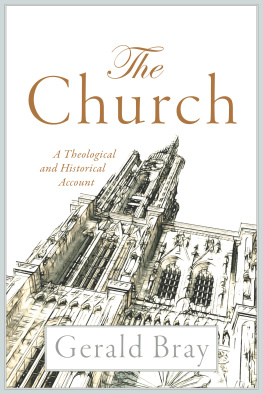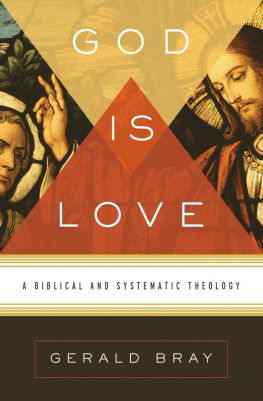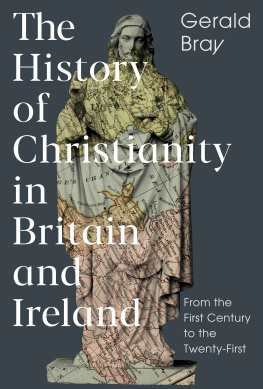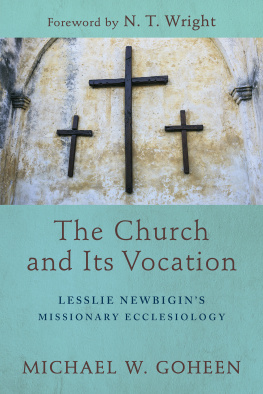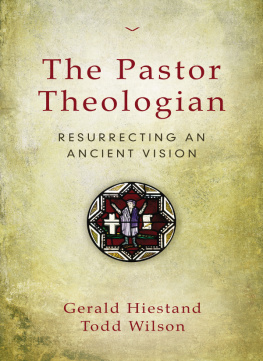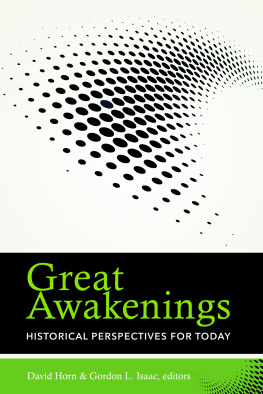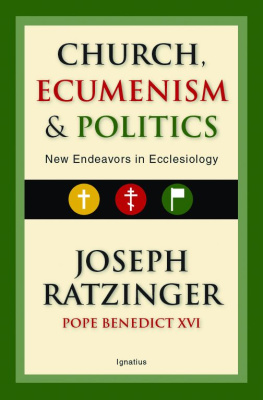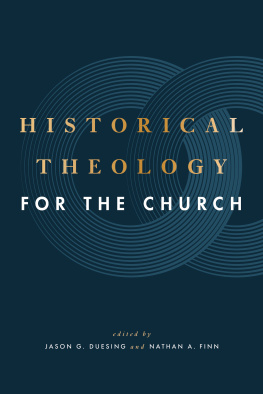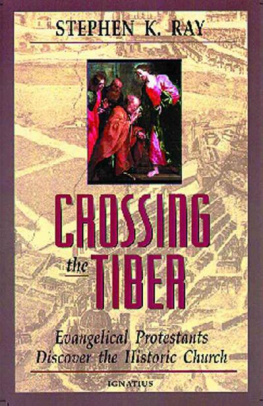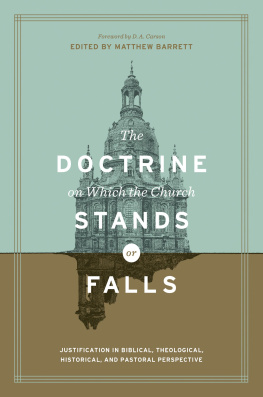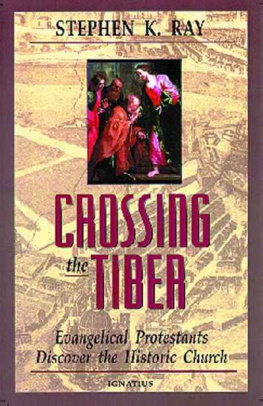Gerald Bray - The Church: A Theological and Historical Account
Here you can read online Gerald Bray - The Church: A Theological and Historical Account full text of the book (entire story) in english for free. Download pdf and epub, get meaning, cover and reviews about this ebook. year: 2016, publisher: Baker Publishing Group, genre: Religion. Description of the work, (preface) as well as reviews are available. Best literature library LitArk.com created for fans of good reading and offers a wide selection of genres:
Romance novel
Science fiction
Adventure
Detective
Science
History
Home and family
Prose
Art
Politics
Computer
Non-fiction
Religion
Business
Children
Humor
Choose a favorite category and find really read worthwhile books. Enjoy immersion in the world of imagination, feel the emotions of the characters or learn something new for yourself, make an fascinating discovery.
- Book:The Church: A Theological and Historical Account
- Author:
- Publisher:Baker Publishing Group
- Genre:
- Year:2016
- Rating:5 / 5
- Favourites:Add to favourites
- Your mark:
- 100
- 1
- 2
- 3
- 4
- 5
The Church: A Theological and Historical Account: summary, description and annotation
We offer to read an annotation, description, summary or preface (depends on what the author of the book "The Church: A Theological and Historical Account" wrote himself). If you haven't found the necessary information about the book — write in the comments, we will try to find it.
Gerald Bray: author's other books
Who wrote The Church: A Theological and Historical Account? Find out the surname, the name of the author of the book and a list of all author's works by series.
The Church: A Theological and Historical Account — read online for free the complete book (whole text) full work
Below is the text of the book, divided by pages. System saving the place of the last page read, allows you to conveniently read the book "The Church: A Theological and Historical Account" online for free, without having to search again every time where you left off. Put a bookmark, and you can go to the page where you finished reading at any time.
Font size:
Interval:
Bookmark:
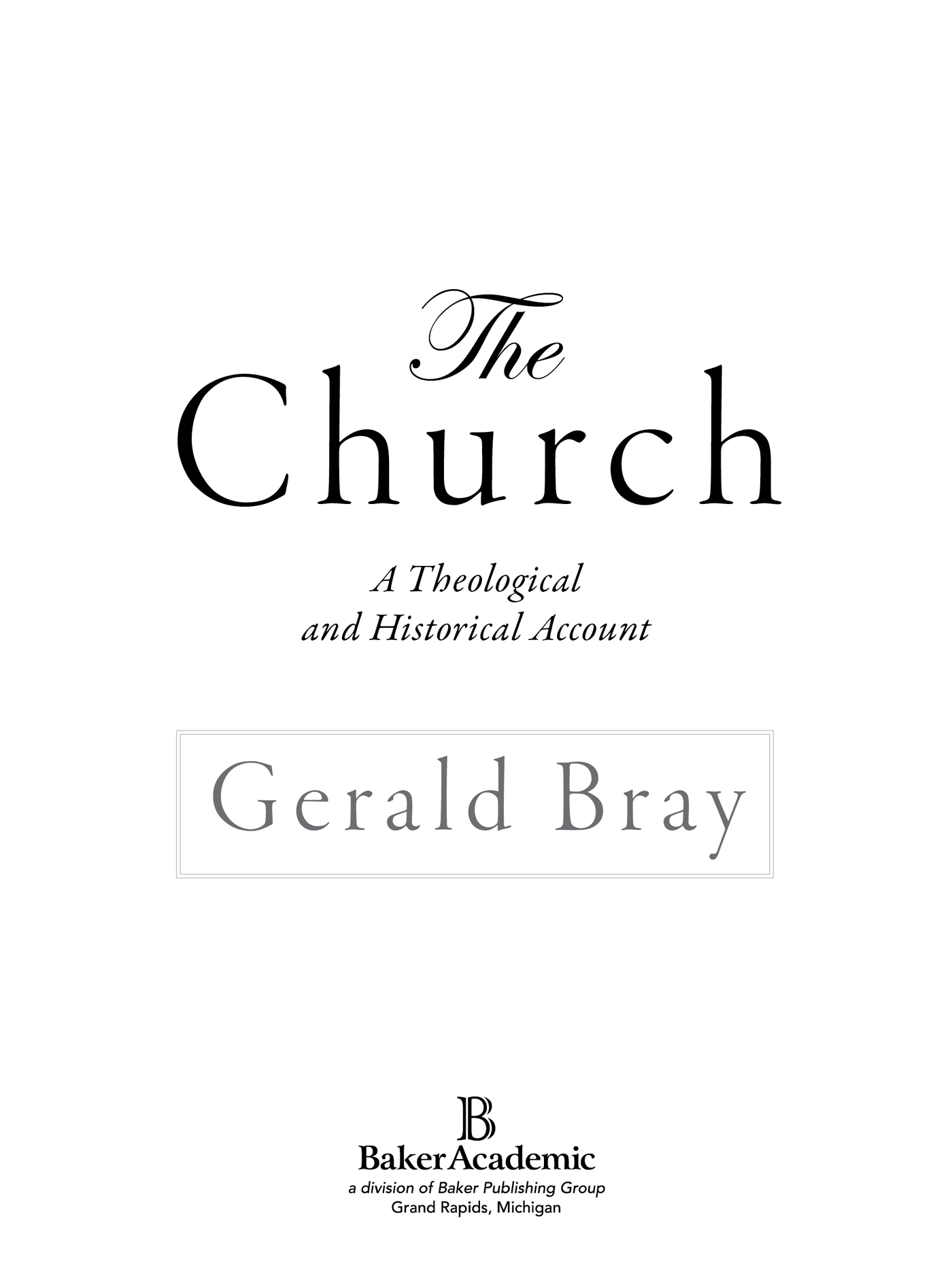
2016 by Gerald Bray
Published by Baker Academic
a division of Baker Publishing Group
P.O. Box 6287, Grand Rapids, MI 49516-6287
www.bakeracademic.com
Ebook edition created 2016
All rights reserved. No part of this publication may be reproduced, stored in a retrieval system, or transmitted in any form or by any meansfor example, electronic, photocopy, recordingwithout the prior written permission of the publisher. The only exception is brief quotations in printed reviews.
Library of Congress Cataloging-in-Publication Data is on file at the Library of Congress, Washington, DC.
ISBN 978-1-4934-0255-7
Scripture quotations are from The Holy Bible, English Standard Version (ESV), copyright 2001 by Crossway, a publishing ministry of Good News Publishers. Used by permission. All rights reserved. ESV Text Edition: 2007
Cover
Title Page
Copyright Page
Preface
1. The Origins of the Church
2. The New Testament Church
3. The Persecuted Church
4. The Imperial Church
5. The Crisis of the Imperial Church
6. What Is the Church?
7. What Should the Church Be?
Appendix: The Ecumenical Councils
For Further Reading
Index of Scripture and Other Ancient Sources
Index of Modern Authors
Index of Selected Names
Index of Subjects
Back Cover
S ince ancient times, almost all Christians have confessed their belief in the one, holy, catholic, and apostolic church, as the Nicene Creed puts it. At the time the creed was composed, that definition of the church was not particularly controversial, and for centuries thereafter hardly anybody thought seriously about what it meant. The church had its quarrels, but although some of them proved to be intractable and led to permanent divisions, most people continued to think that with a little goodwill on all sides, the differences could be patched up and the visible unity of the ancient church restored. It was not until the Protestant Reformation in the sixteenth century that this assumption was seriously challenged, although even then the Reformers continued to insist that the words of the creed expressed their understanding of the church, and they hoped that their proposals would bring back the unity and purity that everyone wanted.
Yet whether they realized it or not, the Reformers were developing conceptions of what the church was that differed from what was commonly believed at the time. They were not interested only in cleaning up corruption or getting rid of obvious abuses in the traditional system. They wanted a church structure that was based on their understanding of New Testament principles, which they believed had been abandoned or forgotten in the course of time. In England there was a serious attempt to marry this new biblical understanding with the traditional pattern of the church, and those who promoted that combination believed that they had hit on the best of both worlds. Unfortunately, as they soon discovered, traditionalists did not accept their doctrines and the more radical Reformers chafed at what they thought were surviving relics of the past that should have been completely rejected. The result was a civil war in which different visions of the church competed with one another. In the end, the original compromise was reinstated, but it could no longer claim a monopoly, and the English-speaking world became a place where rival groups of Christians developed their own ecclesiologies in the form of what we now call denominations.
For better or worse, these denominations are still with us today, with the result that people who are of one mind on the other articles of the creed find themselves interpreting its statement about the church in ways that reflect and perpetuate these post-Reformation divisions. The entire Christian world is affected by this, but whereas in other countries there is usually one dominant church or tradition, it is in those that have been directly affected by the fallout from the English Reformation that ecclesiological issues are most likely to affect the daily life of the average worshiper. It is not for nothing that labels such as episcopal, presbyterian, and congregationalist are commonly used to define particular churchesit is their polity, more than their doctrine, that sets them apart from one another. This is even true of baptists, since the refusal to baptize infants is as much a statement about the nature of the church as it is about the state of a newborn child in the mind of God.
This book is not a history of the church, nor is it an exposition of the churchs doctrine. Rather, it is an attempt to understand how and why the different Christian bodies that now exist have come to understand the church in the ways that they have and why they persist with their own interpretations of ecclesiology even when they know that by doing so they are perpetuating the disunity of the Christian world. The eccentric Anglican ecumenist William Palmer (180385) believed that the church was like a tree that over time had grown and produced different branches. To his mind, the Roman Catholic Church, the Eastern Orthodox churches, and the Anglican Church were the most important of these, and he hoped that they would be able to recognize one another, if not actually reunite, on the basis of their common foundation in the original trunk.
Palmers branch theory of the church did not win much favor at the time and is now regarded as a curiosity rather than as a serious model for ecclesiology, but properly understood, it has more to commend it than might appear at first sight. It is certainly true that over time, the church has grown and expanded across the world. In the process it has split into different branches, not naturally (as Palmer thought) but as the result of conflict, misunderstanding, and political expediency, as well as of incompatible doctrines. The sad fact is that if the church is the body of Christ, it has the wounds to prove it. Many people have written about this history, almost always from their own denominational standpoint, which they want to justify in light of theology, history, and practical experience. Sometimes they portray their own spiritual forebears as saints and heroes who were persecuted, or at least misunderstood, by their contemporaries, who are cast by default in the role of villains. This black-and-white approach is now in retreat, particularly in academic circles, but no one is entirely free of bias, and the old fault lines are often still visible, if only in the way the subject is approached and examined.
As a result, very often ecclesiology is an exposition of what a particular theologian thinks the church ought to be, and not of what it actually is. Sometimes the apologists for a particular position solve this problem simply by excluding from the church those who do not fit their picture of what the church ought to be. The most obvious examples of this can be found in the Roman Catholic tradition, whose theologians, in line with official church teaching, have frequently asserted that anyone not in communion with the see of Rome is outside the church. Others may be more generous when dealing with Christian groups that are not of their own persuasion, and even the Roman church has moderated its stance since the Second Vatican Council (196265), but those who feel strongly that their model of the church is the right one are bound to find it difficult to do justice to other points of view. Only by setting them in historical context and trying to see why each tradition has become what it now is can we gain some perspective on this and look for common elements that underlie our differences and may help us to overcome them. There is no prospect that the church will recover its ancient unity any time soon, and perhaps it never will. But if we can understand one another, we can at least come to terms with one anothers traditions and perhaps even learn from them. That is the aim of this book.
Font size:
Interval:
Bookmark:
Similar books «The Church: A Theological and Historical Account»
Look at similar books to The Church: A Theological and Historical Account. We have selected literature similar in name and meaning in the hope of providing readers with more options to find new, interesting, not yet read works.
Discussion, reviews of the book The Church: A Theological and Historical Account and just readers' own opinions. Leave your comments, write what you think about the work, its meaning or the main characters. Specify what exactly you liked and what you didn't like, and why you think so.

